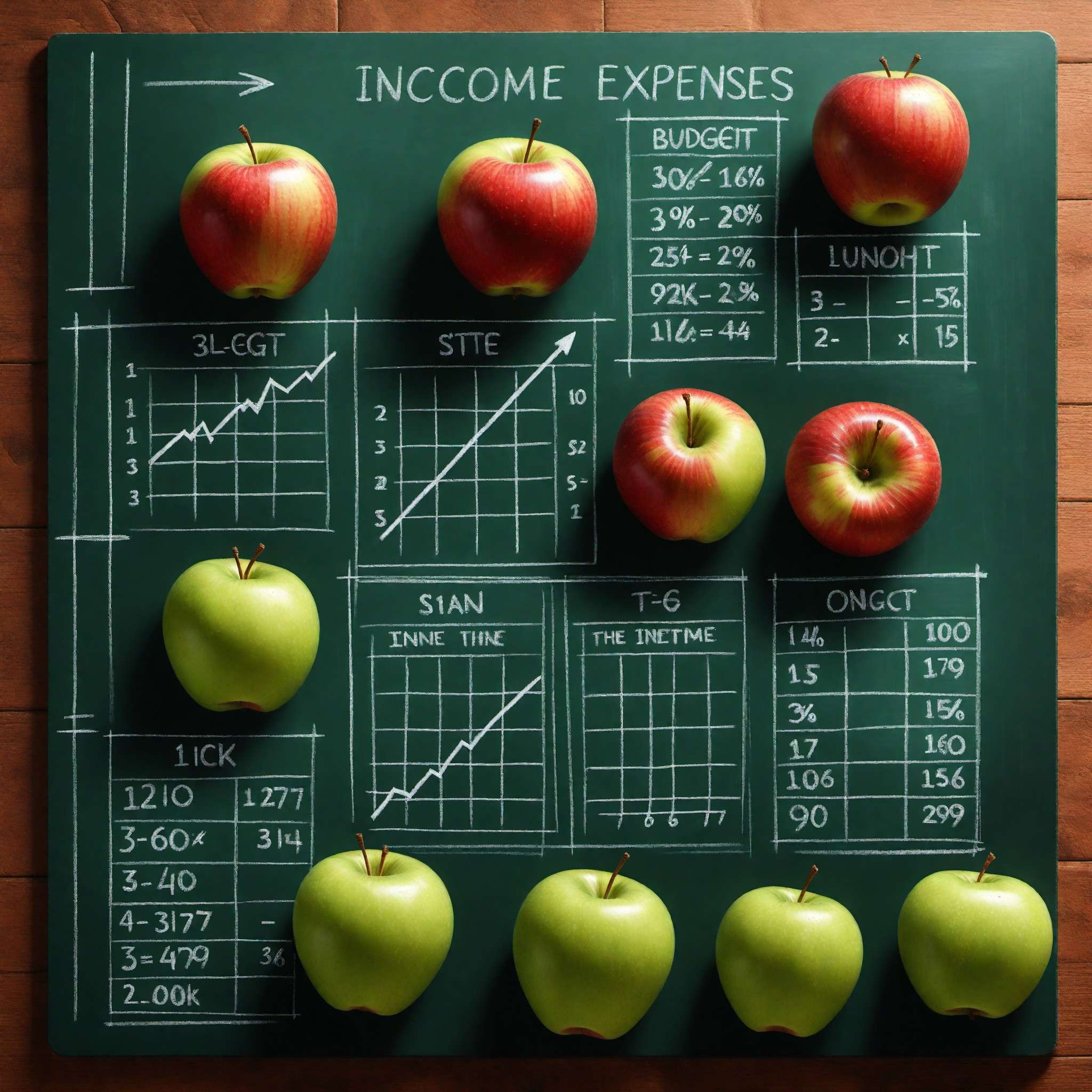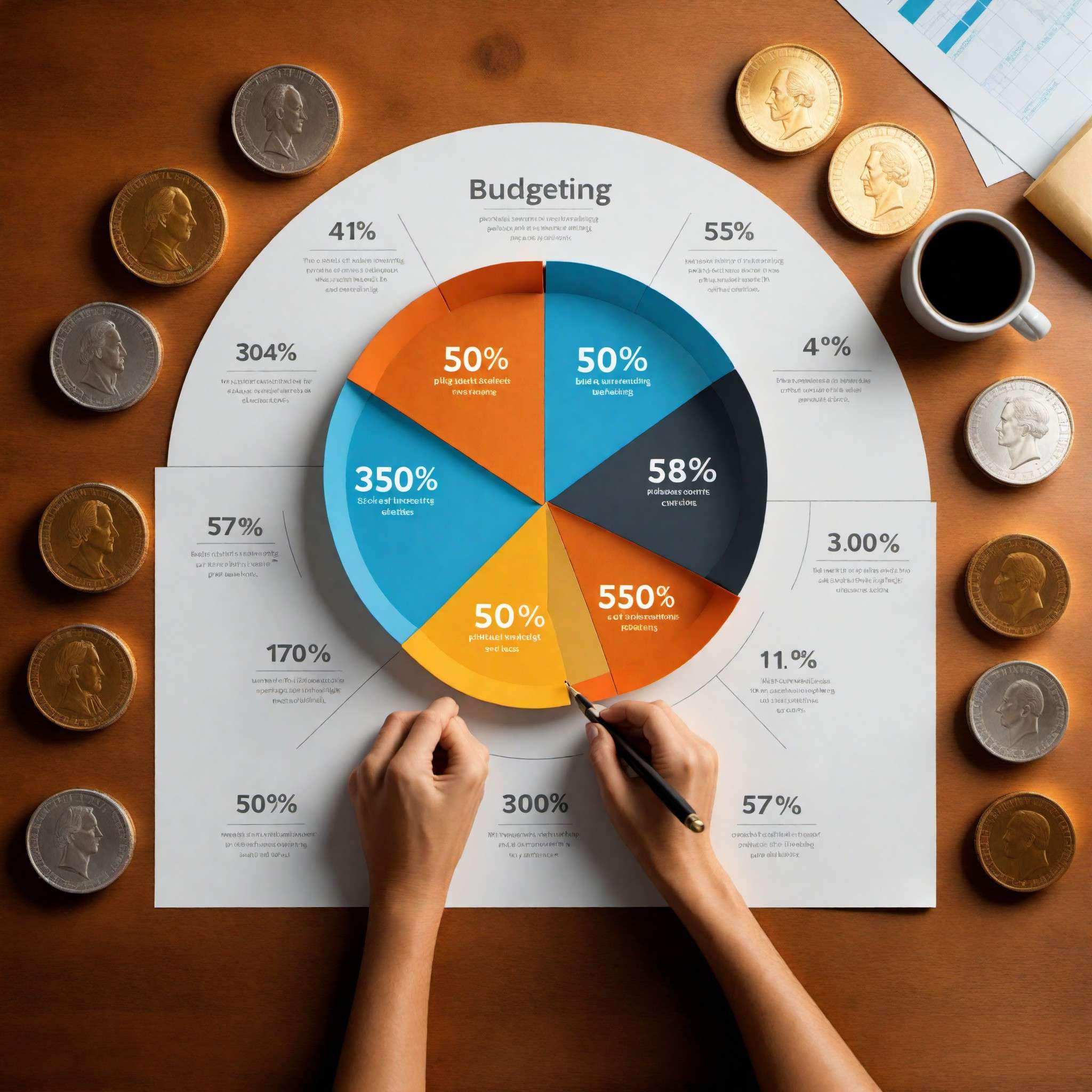Zombie Bunny is Reader-supported and may earn an affiliate commission through links on our site.

10 Unbelievable Budgeting Basics You Probably Don’t Know
Discover eye-opening budgeting basics everyone should know. Maximize your savings and financial stability today! #BudgetingBasics #FinancialFreedom
Discover the power of effective budgeting in achieving financial freedom. This blog post guides you through essential budgeting concepts that are often overlooked yet can revolutionize your financial life. Learn about the zero-based budget, the 50/30/20 rule, the envelope system, sinking funds, paying yourself first, financial automation, cash flow planning, and budget adjustments. Each section provides real-life examples and practical tips to help you understand and apply these techniques. Embrace budgeting as a strategic tool towards financial independence and take control of your money. Start your journey towards financial empowerment today!
Introduction: The Magic of Mastering Money

© Copyright , ZombieBunny.Org
The importance of budgeting
Budgeting, often perceived as a restrictive practice, is in fact a powerful tool that opens doors to financial freedom. By creating and adhering to a budget, you actively control your money rather than allowing your money to control you. It’s not just about cutting expenses or living frugally, but about making informed decisions that help you prioritize your spending in line with your financial goals.
With a budget, you gain a comprehensive understanding of your income and where it’s being spent, allowing you to identify areas of unnecessary expenditure. This awareness is the first step towards modifying spending habits and redirecting funds towards savings or investments. A budget also helps mitigate financial stress by providing a clear picture of your financial situation, thereby eliminating uncertainties. Moreover, budgeting contributes to building a strong credit score, an undeniable asset in today’s world.
Budgeting isn’t merely an act of balancing income and expenses, but a strategic move towards achieving financial independence. It’s a discipline that promotes mindful spending, encourages saving, and fosters a sense of security and control. By understanding the importance of budgeting, you embark on a journey towards financial empowerment, setting the stage for a prosperous and secure future.
Budgeting and financial freedom
Achieving financial freedom is a common aspiration, yet it often seems elusive due to the challenges of managing income, expenses, savings, and debt. However, the crucial tool that can transform this dream into reality is a well-planned budget. A budget serves as a financial roadmap, guiding you towards your financial goals and ultimately, towards financial freedom.
Financial freedom is not about amassing wealth or becoming rich. It’s about having control over your finances so that you can make choices that allow you to enjoy life and secure your future without the constant worry about money. This control is what budgeting offers. By tracking your income and expenses, a budget helps you make smart decisions about how to allocate your funds, ensuring that you live within your means, save for the future, and avoid debt.
Furthermore, budgeting allows you to plan for both short-term and long-term goals. Whether it’s going on a dream vacation, buying a home, or preparing for retirement, budgeting helps you set and achieve these goals by creating a plan to save and invest your money wisely.
The journey to financial freedom is a marathon, not a sprint, and every step you take towards managing your money effectively brings you closer to this goal. Embracing budgeting is embracing a life of financial freedom and security. It’s about taking control, making informed decisions, and becoming the master of your money.
Outline of the blog post
In this blog post, we’re going to explore ten fundamental concepts of budgeting that are often overlooked or misunderstood, yet have the power to revolutionize your financial life. We’ll start by delving into the zero-based budget, which focuses on ensuring every dollar has a purpose. Next, we’ll tackle the 50/30/20 rule, a simple yet effective budgeting guideline that helps maintain a healthy balance between needs, wants, and savings.
From there, we’ll move on to the envelope system, a tangible method of budgeting that encourages mindful spending. We’ll also shed light on the concept of sinking funds and how anticipating expenses can save you from financial strain. Paying yourself first, another crucial budgeting principle, will be addressed, emphasizing the importance of prioritizing savings.
We’ll then explore how automating your finances can save time and effort while ensuring consistency in sticking to your budget. We’ll also delve into cash flow planning, an essential concept that helps manage the ebb and flow of your income and expenses. The topic of budget adjustments will be addressed, focusing on how to navigate financial storms by modifying your budget when necessary.
Throughout this post, we’ll provide real-life examples and practical tips to help you apply these budgeting basics in your own financial journey. By the end, you’ll have a comprehensive understanding of these budgeting techniques, empowering you to take control of your finances and move closer to financial freedom.
The Zero-Based Budget: Your Secret Weapon

© Copyright , ZombieBunny.Org
Understanding zero-based budgeting
Zero-based budgeting, a term coined by Peter Pyhrr in the 1970s, is a method of budgeting where your income minus your expenses equals zero. This doesn’t mean you spend all your income until nothing is left, but it does mean that you need to allocate every single dollar you earn to a specific category in your budget. Essentially, every dollar has a job, whether it’s for living expenses, savings, investments, or debt repayment.
Creating a zero-based budget begins by listing all your sources of income for the month. Next, you outline your expenses, starting with the most necessary ones such as housing, food, and utilities, before moving to discretionary spending such as entertainment or dining out. Remember to include contributions to savings and debt repayment as well. The goal is to make the income minus the expenses equal to zero. If you find you have money left over after allocating to all your categories, put it to work by assigning it to a category such as an emergency fund or a retirement account.
Zero-based budgeting can be a game-changer because it encourages you to be intentional with every dollar you earn. It provides a clear and detailed view of your financial picture and helps identify areas where you might be overspending. By giving every dollar a purpose, you gain control over your money and make conscious decisions about your spending and saving habits.
Benefits of zero-based budgeting
Zero-based budgeting offers several benefits that can significantly improve your financial health. One of the most notable advantages is the heightened sense of control it provides. By assigning a job to every dollar, you take charge of your finances, making intentional decisions about how to spend, save, and invest your money. This proactive approach eliminates the anxiety and uncertainty that often accompany financial management.
Another benefit of zero-based budgeting is its ability to enhance your financial awareness. It requires you to scrutinize every expense, bringing to light any unnecessary or excessive spending. This heightened awareness can lead to more mindful spending habits, helping you cut costs and save more. It also encourages you to prioritize your financial goals, as you must consciously decide where to allocate your funds each month.
Zero-based budgeting can also foster a sense of discipline and responsibility as it demands regular financial check-ins. It’s not a set-and-forget method; you’re required to create a new budget every month, taking into account any changes in income or expenses. This ongoing engagement with your finances can lead to better money management skills.
Lastly, zero-based budgeting can accelerate debt repayment and savings. By assigning every unallocated dollar to debt repayment or savings, you’re likely to reach your financial goals faster. Overall, the benefits of zero-based budgeting make it a powerful tool for anyone aiming to improve their financial situation and work towards financial freedom.
Real-life examples of zero-based budgeting
To better understand the concept of zero-based budgeting, let’s consider a real-life example. Imagine Jane, a software developer, who earns $4000 per month. Using the zero-based budgeting approach, she begins by listing her fixed expenses: $1200 for rent, $200 for utilities, $300 for groceries, $100 for transportation, and $200 for health insurance, totaling $2000.
Next, Jane outlines her variable expenses. She sets aside $200 for dining out, $100 for entertainment, and $50 for personal care. She also allocates $100 towards gifts and charitable donations. These variable expenses add up to $450.
Jane is left with $1550. She decides to allocate $500 to her emergency fund, $500 to her retirement account, and $300 to her vacation savings. She’s also committed to paying off her student loan faster, so she puts the remaining $250 towards her loan repayment.
By giving every dollar a specific job, Jane’s income minus her expenses now equals zero. She has a clear vision of where her money is going, making her more mindful of her spending and saving habits. She also feels more in control and less stressed about her finances.
This is just one example of how zero-based budgeting can work in a real-life scenario. The categories and amounts will differ from person to person, depending on their income, expenses, and financial goals. The key is to ensure every dollar is accounted for and serves a purpose.
50/30/20 Rule: Simplicity in Numbers

© Copyright , ZombieBunny.Org
Explain the 50/30/20 rule
The 50/30/20 rule is a straightforward budgeting guideline that was popularized by U.S. Senator Elizabeth Warren in her book “All Your Worth: The Ultimate Lifetime Money Plan.” This rule offers a simple approach to managing your money by dividing your after-tax income into three categories: needs, wants, and savings or debt repayment.
The 50% portion is allocated to needs. These are the non-negotiable expenses necessary for survival, such as rent or mortgage payments, groceries, utilities, health insurance, and transportation costs. If more than half of your income is being spent on these necessities, you may need to reevaluate your living situation or find ways to reduce these costs.
Next, 30% of your income should be dedicated to wants. This category includes non-essential expenses that enhance your lifestyle, such as dining out, entertainment, hobbies, vacations, and other discretionary spending. The key here is to differentiate between wants and needs. While a smartphone may be a need, the latest model is likely a want.
The remaining 20% is designated for savings or debt repayment. This includes building an emergency fund, saving for retirement, paying off credit card debt, or making extra payments on loans. If you’re debt-free, this money could go entirely into savings or investments.
In essence, the 50/30/20 rule is a balanced, easy-to-follow budgeting guideline that can help ensure you live within your means while saving for the future and enjoying the present.
Benefits of using the 50/30/20 rule
The 50/30/20 rule is lauded for its simplicity and effectiveness, and with good reason. One of the key benefits of this budgeting method is its easy-to-understand principle. It doesn’t require complex calculations or extensive financial knowledge, making it accessible for both budgeting novices and seasoned pros.
By clearly defining what percentage of your income should be allocated to needs, wants, and savings or debt repayment, the 50/30/20 rule provides a solid framework for financial management. It helps ensure that essential expenses are covered, lifestyle choices are funded within reasonable limits, and savings or debt reduction are prioritized.
Another advantage is the flexibility this rule offers. While it provides a guideline, it also allows for personalization based on individual circumstances. For instance, if your essential needs don’t consume 50% of your income, you can adjust the percentages to contribute more to savings or allocate more to personal wants.
The 50/30/20 rule also promotes financial discipline and awareness. It encourages you to differentiate between needs and wants, a crucial skill in maintaining financial health. By ensuring a part of your income is consistently directed towards savings or debt repayment, it fosters good financial habits.
In summary, the 50/30/20 rule is a straightforward, flexible, and practical budgeting tool that encourages balanced spending, consistent saving, and financial awareness, paving the way for better money management and financial freedom.
Real-life examples of the 50/30/20 rule
Let’s consider a real-life application of the 50/30/20 rule with John, a marketing manager earning $4000 after taxes each month. According to the rule, John should allocate 50% of his income, or $2000, to his needs. This could include $1200 for rent, $200 for utilities, $300 for groceries, and $300 for transportation and health insurance.
Next, John allocates 30% of his income, or $1200, for his wants. This might include $200 for dining out, $100 for his gym membership, $200 for entertainment, $300 for vacations, and $400 for shopping and other discretionary expenses. It’s important for John to distinguish between his needs and wants to ensure he stays within his budget.
Finally, 20% of John’s income, or $800, should go towards savings or debt repayment. John decides to put $300 towards his student loan repayment, $200 into his emergency fund, and $300 into his retirement savings account.
By adhering to the 50/30/20 rule, John is able to meet his essential needs, enjoy his lifestyle, and work towards his financial goals. This budgeting method provides a clear structure for John to manage his finances, while still offering the flexibility to adjust the budget based on his needs and goals. It’s a practical, balanced approach to budgeting that can be adapted to fit a variety of income levels and living situations.
Envelope System: Tangible Control Over Your Money

© Copyright , ZombieBunny.Org
Understanding the envelope system
The envelope system is a method of budgeting that involves dividing your income into separate envelopes for different spending categories. This system, attributed to financial guru Dave Ramsey, provides a tangible way to manage your finances, making it particularly effective for visual learners and those who prefer handling physical cash.
Here’s how it works: At the start of each month, after accounting for automatic payments like mortgage or utilities, you’ll divide the remaining cash into different envelopes labeled for various spending categories. These categories typically include groceries, gas, eating out, entertainment, clothing, and so forth. The key is to spend only what’s in each envelope for its designated category. Once the money in an envelope is gone, you can’t spend any more in that category until the next month.
The envelope system forces you to plan your spending and stick to your budget. It eliminates mindless swiping of credit or debit cards, as you can physically see the money leaving the envelope. If you find one envelope emptying faster than others, you’ll have to reassess your spending habits or reallocate funds from other envelopes.
This method of budgeting provides a tangible, visual representation of your spending, making it easier to control and track. By physically handling your money, you become more aware of your spending habits, which can lead to better financial decisions and improved money management.
Benefits of the envelope system
The envelope system carries several benefits that can significantly improve your financial health. Firstly, it offers a visual and tactile representation of your spending. It’s one thing to see numbers on a screen, but it’s another to physically hold the cash and see it deplete as you spend. This tangible aspect of the envelope system can make you more mindful of your spending, leading to more deliberate and thoughtful purchases.
Another benefit is that the envelope system encourages disciplined spending. Since you can only spend what’s in each specific envelope, it prevents overspending and helps you stick to your budget. If an envelope runs out of cash, you need to either wait until the next month or adjust funds from other envelopes, fostering careful financial decision-making.
The envelope system also simplifies the process of tracking your expenses. Instead of having to log into various accounts or check multiple statements, you can see at a glance how much you’ve spent and how much you have left for each category.
Lastly, using the envelope system can reduce the risk of accruing debt. Since you’re only using cash that you already have, it eliminates the temptation to overspend on credit. This can help you live within your means and foster healthier financial habits.
In essence, the envelope system is an effective budgeting tool that promotes mindful spending, disciplined budgeting, simplified expense tracking, and reduced debt.
Real-life examples of the envelope system
Let’s consider a real-world example of the envelope system in action with Emma, a freelance graphic designer. After paying her fixed expenses like rent and utilities through online banking, Emma withdraws the remaining part of her monthly income in cash. She then divides the cash among several envelopes, each labeled with a specific spending category.
Emma has envelopes for groceries, transportation, eating out, entertainment, personal care, and an envelope labeled ‘miscellaneous’ for unforeseen expenses. Each month, she allocates $300 for groceries, $100 for transportation, $200 for eating out, $100 for entertainment, $50 for personal care, and $50 for miscellaneous expenses.
Throughout the month, Emma only spends the cash from the corresponding envelopes. If she goes to the supermarket, she takes the grocery envelope. If she’s planning a night out with friends, she’ll use the entertainment envelope. Seeing the cash physically deplete helps Emma to be more mindful about her spending.
One month, Emma realizes she’s spending her ‘eating out’ envelope too quickly. She decides to cut back on dining out and cook more meals at home, effectively managing her budget.
By using the envelope system, Emma can easily track her spending, make adjustments when necessary, and ensure she’s living within her means. This real-world example shows how the envelope system can provide a tangible, effective method for managing your budget and controlling your spending.
Sinking Funds: Anticipating Your Expenses

© Copyright , ZombieBunny.Org
What are sinking funds
Sinking funds are a budgeting tool designed to help you save for specific expenses that you anticipate in the future. They are essentially mini saving accounts for large, planned expenses, such as holiday gifts, a new car, home repairs or even an annual insurance premium. The goal of a sinking fund is to set aside a little money each month, so when the expense comes due, you have the funds ready and your regular budget isn’t impacted.
To create a sinking fund, you first identify an upcoming expense and determine when you’ll need the money. Then, you calculate how much you need to save each month to reach that amount by the due date. For instance, if you plan to spend $1200 on holiday gifts in December and it’s currently January, you would need to save $100 each month.
Once you’ve determined how much to save, you create a separate category in your budget for this sinking fund. Every month, you contribute the calculated amount to this fund, and only use the money for the intended expense.
Sinking funds allow you to spread out the cost of large expenses over time, making them more manageable. They provide a proactive approach to budgeting, enabling you to anticipate and prepare for expenses, rather than being caught off guard. Utilizing sinking funds can lead to less financial stress, fewer surprises, and better control over your money.
Why incorporate sinking funds in your budget
Incorporating sinking funds into your budget offers several benefits that can lead to a healthier financial life. One of the key advantages is the ability to plan for large expenses. Instead of being hit with a large expense all at once, a sinking fund allows you to break down that cost into manageable monthly savings. This helps to prevent these expenses from derailing your financial plan or leading to debt.
Sinking funds also reduce financial stress. Knowing that you have money set aside for future expenses can provide peace of mind. It eliminates the worry of how you’ll afford these costs, making your financial journey smoother and less anxiety-inducing.
Furthermore, sinking funds encourage disciplined saving. Regularly contributing to a sinking fund helps to establish a habit of saving. Over time, this habit can extend to other areas of your financial life, fostering overall financial responsibility and control.
Sinking funds also prevent the need to dip into emergency savings for non-emergency expenses. Without a sinking fund, you might be tempted to use your emergency fund for planned expenses, leaving you vulnerable in case of an actual emergency.
In essence, sinking funds are a proactive financial tool that promotes planning, reduces stress, encourages disciplined saving, and safeguards your emergency fund. Incorporating sinking funds into your budget can significantly enhance your financial management and stability.
Real-life examples of sinking funds
Let’s illustrate the concept of sinking funds with a real-life example. Meet Lisa, a teacher who loves to take a summer vacation every year. She estimates her vacation will cost about $2400. Since it’s currently January and she plans to take her vacation in July, she has six months to save. Dividing the total cost by six, Lisa determines she needs to save $400 each month for her vacation sinking fund.
Lisa creates a separate category in her budget for this sinking fund and starts setting aside $400 each month. By July, she has saved the full $2400 and can enjoy her vacation without worrying about how to afford it or accumulating debt.
Another example could be a planned home renovation. If Jake, a homeowner, plans to renovate his kitchen next year and estimates the cost to be $12000, he has 12 months to save. By creating a sinking fund and contributing $1000 each month, Jake can fully fund his renovation without resorting to loans or tapping into his emergency fund.
These examples show how sinking funds work in real-life scenarios. By breaking down large expenses into smaller, manageable savings goals, sinking funds allow you to anticipate and prepare for future costs. This proactive approach to budgeting can lead to less financial stress, fewer surprises, and a greater sense of control over your money.
Pay Yourself First: Prioritize Saving

© Copyright , ZombieBunny.Org
Understanding the concept of paying yourself first
“Paying yourself first” is a fundamental principle in personal finance, and it’s as simple as it sounds. Instead of paying your bills and other expenses first, and then saving whatever is left, this principle dictates that you should set aside a portion of your income for savings as soon as you receive it.
The primary goal of paying yourself first is to ensure that you’re prioritizing your future financial security and goals. This could involve contributing to a retirement fund, building an emergency fund, saving for a down payment on a house, or investing in a stock portfolio.
To pay yourself first, you decide on a certain percentage of your income that you want to save. Then, as soon as you receive your paycheck, you transfer this amount into your savings or investment account before you start paying your bills or spending on other expenses. The suggested saving rate can vary depending on your financial goals and income, but a common recommendation is to save at least 20% of your income.
Paying yourself first encourages a habit of saving and ensures that saving is treated as a non-negotiable expense, just like rent or utility bills. It’s a strategy that promotes financial responsibility and prioritizes long-term financial health over immediate gratification. By adopting the pay yourself first method, you’re making a conscious decision to invest in your financial future.
The importance of paying yourself first
The importance of paying yourself first cannot be overstated when it comes to achieving financial security and independence. This practice is crucial for several reasons.
Firstly, paying yourself first ensures that you are prioritizing your savings. By treating savings as a non-negotiable expense, you make sure that a portion of your income is consistently being saved. This helps build a robust savings account and brings you closer to your financial goals.
Secondly, it fosters financial discipline. By saving first, you’re learning to live within your means and manage your money effectively. This discipline can help prevent overspending and encourage healthier financial habits.
Thirdly, paying yourself first can accelerate your journey towards financial goals. Whether it’s buying a house, starting a business, or planning for retirement, saving first can help you reach these milestones faster. It’s a proactive approach to building wealth and securing your financial future.
Moreover, it provides a buffer against financial emergencies. Having a well-funded emergency savings account can provide peace of mind and financial security, knowing you can handle unexpected expenses without going into debt.
In essence, paying yourself first is an act of self-care. It’s a way of prioritizing your financial wellness, securing your future, and cultivating financial discipline. It puts you in control of your money, ensuring you’re not just working for your money, but your money is also working for you.
Real-life examples of paying yourself first
Let’s illustrate the concept of paying yourself first with a real-life example. Consider Alex, who just landed his first job with a monthly salary of $3000. Alex decides to follow the principle of paying himself first by saving 20% of his income each month.
As soon as Alex receives his salary, he transfers $600 (20% of $3000) into his savings account. He does this before he pays any bills or spends on other expenses. This ensures that Alex is consistently saving and building his financial future. Over a year, Alex will have saved $7200, not including any interest earned if he’s placed the money in a high-yield savings account.
Another example could be Sophia, a single mother working two jobs. Despite her tight budget, Sophia commits to saving 10% of her income for her son’s college fund. No matter how tight things get, she treats this saving as a non-negotiable expense and pays herself first before dealing with any other expenses.
These examples show how paying yourself first works in real-life scenarios. Regardless of the amount or percentage you choose to save, the key is to make saving a priority. By paying yourself first, you ensure that your future financial security and goals are at the forefront of your financial plan. This habit can lead to long-term financial health and wealth accumulation.
Automating Finances: Let the Machines Do It

© Copyright , ZombieBunny.Org
Benefits of automating your finances
Automating your finances is a simple yet powerful tool that can have a tremendous impact on your financial health. One of the major benefits of financial automation is the convenience it offers. Instead of having to remember to pay each bill or transfer money to savings, automation does the work for you. This can save you time and effort, and eliminate the stress of potentially forgetting a due payment.
Another significant benefit is that automation ensures consistency in saving and bill payments. By setting up automatic transfers to your savings account, you’re implementing the ‘pay yourself first’ principle. This ensures a portion of your income is consistently being saved, helping you reach your financial goals faster.
Financial automation also reduces the risk of late payments and the associated fees. By scheduling automatic payments for your bills, you ensure they’re paid on time every month, which can also protect your credit score.
Moreover, automating your finances can help curb impulsive spending. If money is automatically transferred to savings or to pay bills, it’s less likely to be spent on non-essential items.
In essence, automating your finances provides convenience, ensures consistency, eliminates the risk of late payments, and can help control impulsive spending. It’s a tool that leverages technology to simplify financial management and help you stay on track with your financial goals.
How to automate your finances
Automating your finances is a relatively straightforward process that involves a few key steps. Firstly, you need to identify which aspects of your finances can be automated. Common areas include bill payments, savings contributions, debt repayments, and investment contributions.
Next, you need to set up automatic payments. Most service providers, from utilities to credit card companies, offer the option to automate payments. You can usually set this up through the provider’s website or app. You’ll need to provide your bank account information and choose a date for the automatic payment.
For automating savings, you’ll want to set up an automatic transfer from your checking account to your savings account. Determine how much you want to save each month and schedule the transfer for shortly after you receive your paycheck. This is a practical way to implement the ‘pay yourself first’ principle.
Investment contributions can also be automated. Many brokerage firms allow for automatic contributions to investment accounts. Decide on the amount and frequency, and let the automation do the work for you.
Finally, review your automated finances regularly. While automation can help manage your money, it’s still important to check in regularly to ensure everything is functioning as expected and to make any necessary adjustments.
By automating your finances, you’re leveraging technology to manage your money effectively, save time, avoid missed payments, and steadily work towards your financial goals.
Real-life examples of finance automation
Consider the real-life example of Maria, who works a full-time job and runs a side business. With her busy schedule, it’s challenging for her to manage her finances manually. To streamline her financial processes, Maria decides to automate her finances.
Maria sets up automatic bill payments for her fixed monthly expenses, such as her mortgage, utilities, and internet. She schedules these payments to occur just after her paycheck is deposited to ensure she has sufficient funds. This automation ensures her bills are paid on time every month, eliminating the need to remember due dates and preventing late fees.
Next, Maria automates her savings. She decides to save 20% of her monthly income. So, she sets up an automatic transfer to move this amount from her checking account to her savings account each month. This ensures she is consistently saving and growing her emergency fund and retirement savings.
Lastly, Maria automates her credit card payments to pay the full balance every month. This helps her avoid interest charges and maintain a good credit score.
By automating her finances, Maria can focus more on her work and less on managing her money. She no longer worries about missing bill payments or forgetting to transfer money to savings. This real-world example demonstrates how automating finances can streamline financial management, ensure consistency, and reduce financial stress.
Cash Flow Planning: Mastering the Ebb and Flow

© Copyright , ZombieBunny.Org
Understanding cash flow planning
Cash flow planning is a strategic financial management tool that helps you understand the inflow and outflow of cash in your personal finances. The main aim of cash flow planning is to ensure you have enough cash available to meet your financial obligations while also investing in your financial goals.
In a nutshell, cash flow planning involves tracking how much money is coming in (income) and how much is going out (expenses) over a certain period, typically a month. Your income could be from several sources, including your salary, dividends, rental income, or any other revenues. Your expenses include all the money you spend, such as mortgage or rent, bills, groceries, entertainment, and savings or investment contributions.
Once you’ve tracked your income and expenses, you subtract the expenses from the income to determine your net cash flow. If the result is positive, you have a surplus, which could be used to pay off debt faster, increase your savings, or invest. If the result is negative, you have a deficit, indicating you’re spending more than you earn, which may require you to cut back on expenses or find ways to increase your income.
Understanding your cash flow is critical to maintaining financial health. It gives you a clear picture of your financial situation, helps you make informed decisions, and allows you to plan for the future. It’s an essential step in achieving financial stability and reaching your financial goals.
Benefits of cash flow planning
Cash flow planning brings several benefits that can significantly enhance your financial management. Firstly, it gives you a clear picture of your financial situation. By tracking your income and expenses, you gain a complete understanding of where your money is coming from and where it’s going. This transparency can help you make informed financial decisions.
Secondly, cash flow planning can help detect potential financial issues before they become serious. If your cash flow planning reveals a recurring deficit, it indicates that you’re spending more than you’re earning, which could lead to debt if not addressed. Identifying this early allows you to take corrective measures, such as cutting expenses or finding ways to increase income.
Cash flow planning also helps you plan for the future. By understanding your cash flow, you can more effectively plan for large purchases, investments, or other financial goals. It allows you to strategize and make adjustments to achieve these goals.
Moreover, effective cash flow planning encourages financial discipline. By regularly monitoring your cash flow, you become more mindful of your spending and saving habits. This can foster healthier financial behaviors and promote financial stability.
In essence, cash flow planning offers clarity, early problem detection, effective future planning, and promotes financial discipline. It’s a powerful tool that can help you take control of your finances and navigate towards your financial goals.
Real-life examples of cash flow planning
Let’s consider a real-world example of cash flow planning with Tom, a small business owner. Tom earns varying amounts each month, so understanding his cash flow is crucial. At the beginning of each month, Tom projects his income based on his scheduled projects and ongoing contracts.
Next, he lists his fixed expenses, such as office rent, utilities, and salary payments. He also accounts for variable expenses, such as supplies, travel, and meals. He then subtracts his total expenses from his projected income to calculate his net cash flow.
One month, Tom’s cash flow planning reveals a projected deficit. To address this, he decides to cut back on non-essential expenses and seeks additional projects to increase his income for the month. By doing so, he manages to turn the deficit into a surplus.
In another scenario, consider Linda, a retiree living on a fixed income. Linda uses cash flow planning to ensure she can cover her expenses and continue saving. She calculates her monthly income from her pension and any investments, then subtracts her expenses, including housing, healthcare, groceries, and leisure activities. If her cash flow planning reveals a surplus, she puts the extra money into her emergency savings fund.
These examples show how cash flow planning works in real-life scenarios. By understanding the flow of money in and out, both Tom and Linda can make informed decisions, plan for the future, and maintain financial stability.
Budget Adjustments: Navigating Financial Storms

© Copyright , ZombieBunny.Org
Recognizing the need for budget adjustments
Recognizing the need for budget adjustments is a crucial aspect of successful financial management. Life is dynamic, and your budget should be too. Changes in income, expenses, or financial goals may necessitate adjustments to your budget.
A decrease in income is one of the most common reasons for budget adjustments. This could be due to a job loss, a pay cut, or a decrease in business revenue. When your income decreases, you’ll need to adjust your budget to ensure you’re living within your means. This may involve cutting back on non-essential expenses, seeking additional sources of income, or dipping into your savings.
An increase in expenses can also prompt budget adjustments. This could result from increased living costs, unexpected expenses, or new financial obligations. In this case, you may need to allocate more of your budget to cover these costs. This could involve reducing spending in other areas or finding ways to increase your income.
Changes in financial goals can also necessitate budget adjustments. If you decide to buy a house, start a business, or retire early, you’ll need to adjust your budget to accommodate these goals. This might involve increasing your savings rate, reallocating funds, or adjusting your spending habits.
Recognizing the need for budget adjustments and making these changes in a timely manner can help you maintain financial stability, adapt to life’s changes, and stay on track with your financial goals. It’s a key part of proactive financial management.
How to adjust your budget
Adjusting your budget involves a few key steps. Firstly, identify the reason for the adjustment. Is your income decreasing, are your expenses increasing, or have your financial goals changed? Once you understand the cause, you can make appropriate changes.
If your income has decreased, start by reviewing your expenses. Prioritize essential costs such as housing, food, and healthcare. Non-essential expenses like entertainment, eating out, or luxury purchases may need to be reduced or eliminated. Consider ways to increase your income, perhaps through a side job or by selling items you no longer need.
If your expenses have increased, evaluate where the increase is coming from. If it’s a necessary expense, you may need to reduce spending in other areas to accommodate it. If it’s an unnecessary expense, consider removing it altogether. Always look for areas where you can cut back without significantly impacting your quality of life.
If your financial goals have changed, adjust your budget to reflect these new goals. If you’re saving for a down payment on a house or planning for early retirement, you’ll likely need to allocate more of your budget towards savings. This might involve reducing discretionary spending or finding ways to boost your income.
Remember, budgeting is a fluid process that should adapt to your life’s changes. Regularly review and adjust your budget to ensure it serves your current financial situation and goals. By doing so, you can navigate financial storms and keep your finances on track.
Real-life examples of budget adjustments
Consider John, who recently lost his job and experienced a decrease in income. To adjust his budget, John prioritizes his essential expenses, such as rent, utilities, and groceries. He reduces his non-essential spending, cutting back on dining out, entertainment, and shopping. He also starts looking for part-time work to supplement his income until he can find a new full-time job.
In another scenario, consider Emily, who recently had a baby and experienced an increase in expenses. To adjust her budget, Emily identifies the new costs associated with her baby, such as diapers, baby food, and healthcare. She reallocates funds from non-essential areas, like entertainment and dining out, to cover these new expenses. Emily also decides to work additional hours to increase her income and comfortably cover her increased expenses.
Lastly, consider Mike, who decided to buy a house sooner than initially planned. To adjust his budget, Mike increases the amount he sets aside for savings each month. He reduces his discretionary spending, such as vacations and luxury purchases, to accumulate the down payment faster. Mike also takes on some freelance work to boost his savings.
These real-life examples illustrate how budget adjustments can help navigate financial changes. Whether it’s a decrease in income, an increase in expenses, or a change in financial goals, adjusting your budget can help you maintain financial stability and achieve your financial objectives.
Conclusion: Embrace the Journey of Financial Empowerment

© Copyright , ZombieBunny.Org
Recap of the budgeting basics
Mastering these budgeting basics can significantly enhance your financial health and bring you closer to your financial goals. We’ve discussed the power of sinking funds in anticipating and preparing for large expenses. By breaking down big costs into manageable monthly savings, sinking funds help avoid financial strain and promote disciplined saving.
We’ve also delved into the principle of ‘paying yourself first’, a strategy that prioritizes saving and contributes to financial security. By setting aside a portion of your income for savings before paying any bills, you ensure consistent saving and foster financial discipline.
Furthermore, we’ve explored the benefits of automating your finances. From ensuring timely bill payments to fostering consistent saving habits, automation leverages technology to simplify financial management and help you stay on track with your financial goals.
We’ve also tackled cash flow planning, a tool that provides a clear understanding of your income and expenses, helping you make informed financial decisions and plan for the future effectively.
Finally, we’ve highlighted the importance of recognizing the need for budget adjustments. Life is dynamic, and your budget should be too. Adapting your budget to changes in income, expenses, or financial goals is crucial to maintaining financial stability.
By embracing these budgeting basics, you’re embarking on a journey of financial empowerment. These strategies equip you with the knowledge and tools to take control of your finances and navigate towards financial prosperity.
The path to financial freedom
The path to financial freedom isn’t a straight line; it’s a journey filled with ups and downs, twists and turns. But with the right tools and strategies, it’s a journey that can lead to financial stability, security, and independence.
Implementing the budgeting basics discussed in this blog post is a crucial step on this path. By understanding and utilizing sinking funds, you can better anticipate and prepare for significant expenses, thereby avoiding unnecessary debt and financial strain.
Embracing the ‘pay yourself first’ principle puts your future financial security at the forefront. By consistently setting aside a portion of your income for savings, you’re investing in your financial future and cultivating a habit of saving.
Automating your finances can streamline financial management, ensure consistency in saving and bill payments, and reduce the risk of late fees. It’s a way to leverage technology to keep your finances on track.
Understanding and implementing cash flow planning can provide a clear picture of your financial situation, enabling informed decision-making and effective future planning.
Recognizing when budget adjustments are needed and adapting accordingly ensures your budget aligns with your current financial situation and goals. It’s a proactive approach to navigating life’s financial storms.
By mastering these budgeting basics, you’re equipping yourself with the tools and knowledge to navigate the path to financial freedom. It’s about taking control of your finances, making informed decisions, and embracing the journey of financial empowerment.
Final thoughts and encouragement
Budgeting may seem daunting at first, but it’s a powerful tool that can transform your financial life. Remember, budgeting isn’t about restricting your spending; it’s about understanding your finances and making informed decisions that align with your financial goals and values.
The budgeting basics shared in this blog post aren’t just theories; they’re practical tools that have helped countless individuals navigate their financial journey. From understanding the power of sinking funds to embracing the ‘pay yourself first’ principle, from leveraging the convenience of financial automation to mastering the ebb and flow through cash flow planning, and finally, understanding when and how to adjust your budget – these are all stepping stones on your path to financial freedom.
But remember, the journey to financial freedom isn’t a sprint; it’s a marathon. It requires patience, discipline, and persistence. There will be setbacks, but don’t let them discourage you. Use them as learning opportunities and make the necessary adjustments.
Lastly, remember that it’s your journey. Everyone’s financial situation is unique, so what works for one person might not work for another. Customize these budgeting basics to fit your individual needs and goals.
As you embark on your journey, know that financial freedom is within your reach. Embrace the journey, stay committed, and you’ll see the transformative power of effective budgeting. Financial empowerment is not just a destination—it’s a journey that begins with the first step.
Please support our site and purchase something from our store.







